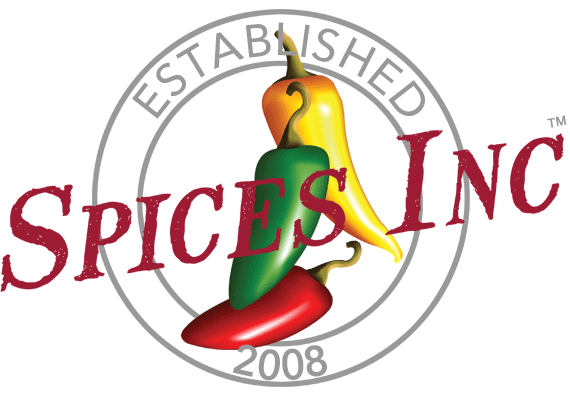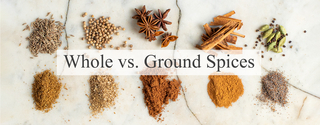Whole Spices vs Ground Spices
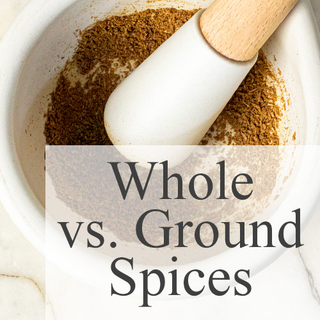
Whole Spices vs Ground Spices 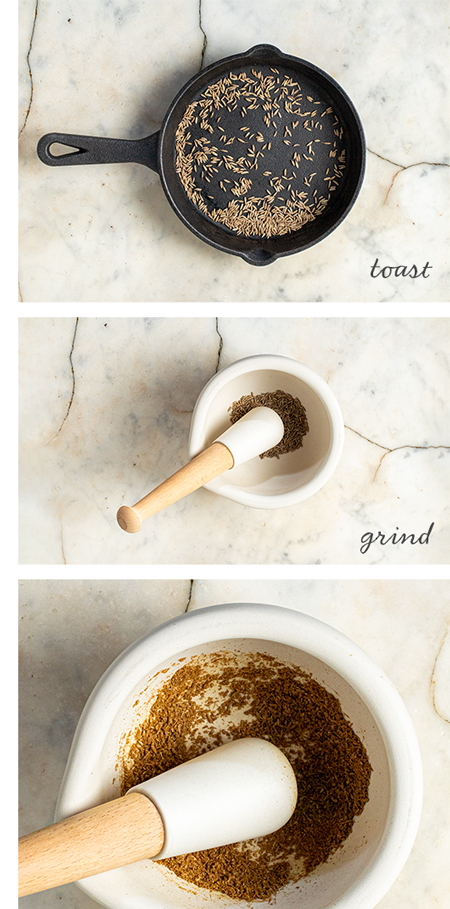
We’re often asked, what’s the difference between whole and ground spices, and what’s better to use when cooking? The short answer is: Ground spices are just whole spices turned into powder, and both are useful in the kitchen when you consider their properties. The dried spice seed is torn apart during grinding, exposing the volatile oils—chemical compounds that define a spice’s flavor—that are locked inside.
Toasting or roasting whole spices can help “wake up” those volatile oils, which allows the flavors to deepen and become more vibrant. To do this, put whole spices in a dry pan over medium heat and let them toast. Swirl them around in the pan to prevent burning. If your pan is hot, it should only take 2-3 minutes to complete the dry toasting.
Whole spices can also be dry roasted in the oven, and this method is often the choice if your oven is already in use or you don’t have the stovetop space for another pan. Heat the oven to 350°F; when it’s ready, put your spices in a rimmed pan or baking sheet and place it in the oven. Check after 2 or 3 minutes on their doneness. They should be ready in about 5 minutes.
Once the toasted spices are cool enough to handle, they can be ground and used immediately.
Ground spices can be toasted before use, but the process is different. They burn easily without any buffer between them and the hot pan. To pre-toast ground spices, put them in a pan with oil and let the spices “bloom” in the fat for about a minute. This is often done right at the beginning of cooking and can enhance their flavor, but ground spices can also be added directly to a recipe without blooming.
Swapping Whole Spices for Ground
Ground spices are more flavor-forward than whole spices because the exposed volatile oils are easy for your tongue to access. To extract the flavor of whole spices, you need to take extra steps. You can grind them yourself or use them whole, allowing the flavors to steep out of the spice and into the surrounding cooking material.
When you swap out whole spices and use ground spices instead, you need to consider the freshness of your ground spice. The longer a spice has been ground, the longer its volatile oils have been exposed to light and air. Exposing volatile oils to light and air makes them susceptible to degradation and evaporation.
Depending on storage conditions, whole spices will retain their freshness for one to two years, while ground spices will start to lose their piquancy after about six months. These timeframes are just a rule of thumb, though. Spices stored away from direct sunlight, in a cool cabinet or pantry, can retain their flavors longer than these estimates. Every spice should be evaluated individually to see if it still has potency.
The easiest way to test a spice’s potency is to smell and taste it. If it doesn’t taste as vibrant as it once did or seems to have lost some aroma, you may need to add a little more of that ground spice than the recipe calls for. Ground spices that have lost their smell entirely or taste bland or dusty should be discarded.
How Much Ground Spice To Use Instead of Whole Spice
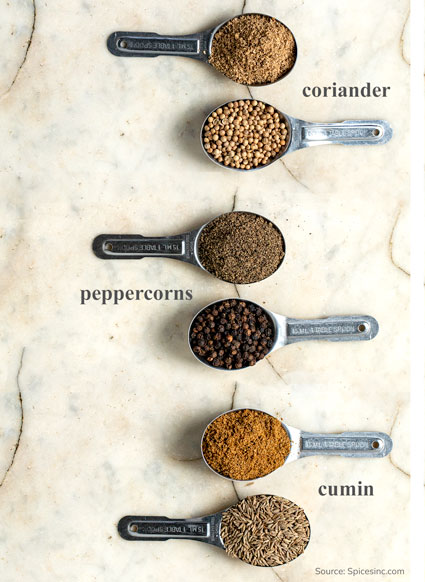
To use ground spice instead of whole spice, the most straightforward conversion is to use about three-quarters as much ground as you would whole. If a recipe calls for a teaspoon of whole coriander, use ¾ teaspoon of ground coriander. There are, of course, factors to take into consideration.
Ball-shaped spices, like round peppercorns or coriander seed, don’t sit neatly in a stack in your measuring spoon. There are pockets of space between them. If you were to break them up, they would take up much less space, hence the idea of ¾ teaspoon ground spice for each teaspoon whole.
Smaller spices, like cumin or caraway, lay much more neatly together in a measuring spoon, so there is less space between the seeds. These spices come closer to a 1:1 ratio.
These ratios all presume the ground spices are relatively fresh; if they are a little bit older, you may need to use more ground spices to compensate for the loss of volatile oil content.
All ratios discussed here are rough guidelines for converting spices for measurement, but the best way to check your spice levels is to taste your dish. If you’re unsure of the age of your ground spices or are uncomfortable determining the general size and shape of the whole spice, start with smaller amounts. You can begin the cooking process by adding as little as ½ the spice that was initially called for, and then taste along the way and add more ground spice as necessary.
Grinding Your Spices
The easiest way to grind your spices at home is with a dedicated spice grinder or coffee grinder. Coffee or electric grinders are the right choices if you want to pulverize your spice into a fine powder. Depending on the power of your grinder, it can be difficult to stop the blades before you have a fine grind. Try a mortar and pestle if you want something a bit more coarse that will add texture.
Spices ground after toasting tend to have a fuller, more robust flavor than purchased, pre-ground spices. The volatile oils have remained housed inside the walls of the spice, so they haven’t had as much chance to evaporate or degrade.
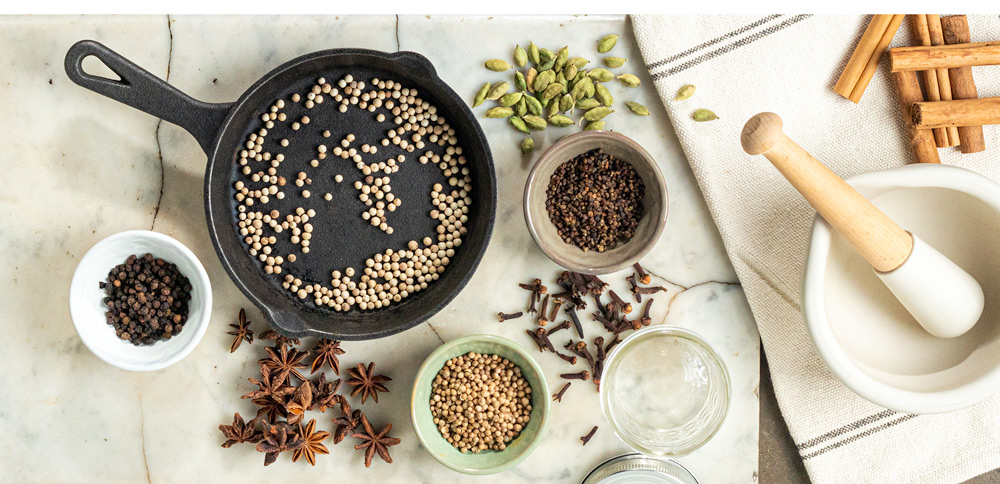
Cooking with Whole Spices
Whole spices should always be added at the beginning of cooking to give the flavor ample time to be absorbed into the recipe.
Some whole spices, like fennel and mustard seeds, can be left in a dish without too much concern. Biting into cooked whole mustard or fennel seed can even be a pleasant surprise since they can deliver an extra pop of flavor and texture.
Many whole spices, though, should be removed at the end of cooking. Pungent spices like peppercorns or cloves are unpleasant to bite into. Spices like star anise or cinnamon will continue to flavor the dish long after cooking has stopped.
Part of the challenge of cooking whole spices revolves around knowing when and how to add or remove them from a dish.
Whole spices can be added to a dish by infusing them with a small muslin bag or a piece of cheesecloth tied closed with kitchen twine. Put the spices into the bag or lay them on the cheesecloth. Close or tie the bag shut, and drop it into your recipe to simmer. Remove the bag before serving.
If you bloom whole spices in oil before cooking, pull them out of the oil with a spoon, put them in your infusion bag, and then add the bag to your recipe. Remove it as you would any other infusion before you’re ready to eat.
Boost the flavor of a dish made with whole spices by layering in ground spices near the end of cooking time. This will present the flavors of these spices to the fullest degree.
Don’t be intimidated because a whole spice looks unfamiliar. Toast whole spices to maximize their flavor in a dry pan, in the oven, or in oil. Ground spices can be added intermittently throughout cooking, adding layers of flavor; whole spices should be added early so their flavor can fully permeate their dish. And whole and ground spices can be used in conjunction with one another. They are compatible ingredients that provide a full range of flavors and can bring our dishes to new heights when appropriately used.
